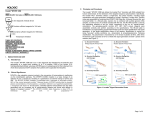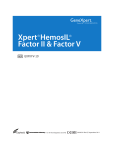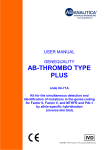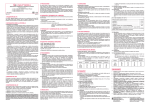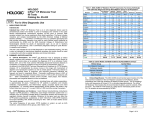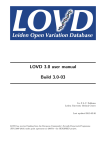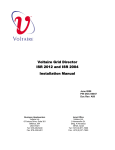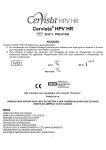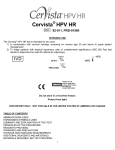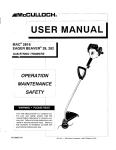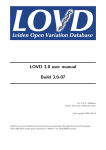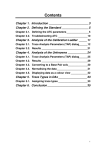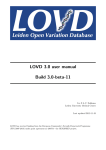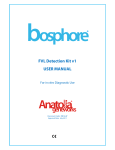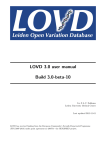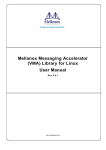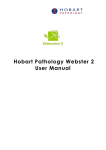Download Hologic FV IVD Package Insert
Transcript
C. Principles and Procedures Invader Factor V 95-453: 144 tests or 95-457: 1680 tests In vitro diagnostic medical device Contains sufficient reagents for 144 tests Contains sufficient reagents for 1680 tests Temperature limitation INDICATIONS AND USE MATERIAL AND METHODS SAFETY ISSUES INSTRUCTIONS FOR USE BIBLIOGRAPHY CONTACT INFORMATION NOTICE TO RECIPIENT ABOUT LIMITED LICENSE LIMITED PRODUCT WARRANTY I. INDICATIONS AND USE The Invader Factor V test utilizes the Invader Plus chemistry with DNA isolated from human whole blood, for the detection of the targeted sequence polymorphism. Specifically, the Invader Plus chemistry utilizes a single-tube, two phase reaction, including target amplification and signal generation (mediated by Invader chemistry). Invader Plus reaction mixes are assembled by combining the Factor V Oligo Mix, Universal Enzyme Mix, and Universal Buffer. In a 96-well plate, reaction mix is combined with purified genomic DNA samples, as well as four (4) controls included with the test. The No DNA Control is used by the interpretive software to set the "noise" component of the run for "signal-to-noise" calculations. The genotype-specific controls (WT, HET, MUT) ensure reagents were assembled correctly and perform according to the specifications. The 96-well plate is transferred to an appropriately programmed thermal cycler for target amplification and signal generation. In the target amplification phase of the reaction, amplification is carried out using "two-step" cycling conditions (i.e., denaturation & annealing/extension). Following amplification, Taq polymerase is inactivated by a 10 minute incubation at 99°C, after which the thermal cycler proceeds to 63°C to initiate the signal generation (Invader) phase of the reaction (see Figure 1). 1a. Structure Formation: Wildtype Specific Primary Probe 2a. Structure Formation: Mutation Specific Primary Probe 1b. Structure Recognition and Cleavage: 2b. Structure Recognition and Cleavage: 1c. Secondary Reaction: 2c. Secondary Reaction: A. Intended Use ® The Invader Factor V test is an in vitro diagnostic test intended for the detection and genotyping of a single point mutation (G to A at position 1691) of the human Factor V gene in isolated genomic DNA obtained from whole blood potassium EDTA samples from patients with suspected thrombophilia. B. Clinical Significance The Factor V Leiden (FVL) mutation refers to a base change from guanine (G) to adenine (A) at position 1691 in the gene coding for the Factor V protein, an amino acid substitution that eliminates one of three activated protein C cleavage sites in Factor V. As a result, Factor V is inactivated to a lesser extent and persists for a longer period in the circulation, 1,2 leading to more thrombin generation. In the United States, a single FVL allele is present in about 5, 2.2, and 1.2 percent of the Caucasian, Hispanic, and African American populations, 4,5 respectively; overall, about 1 in 5,000 individuals is homozygous for the mutation. The FVL mutation has been estimated to be present in 15 to 20 percent of patients with first 1 venous thromboembolism (VTE) and is the most common heritable prothrombotic risk factor in the United States. In population-based studies, FVL increases the risk of a first VTE 1,2,3 4- to 7-fold in heterozygous individuals and 40- to 80-fold in homozygous individuals. ® Invader Factor V FRET Cassette (FAM) FRET Cassette (RED) FLUORESCENCE 1 : RED FLUORESCENCE 2: FAM ® Figure 1: Invader Signal Generation Phase. Page 1 of 9 During the signal generation phase, a discriminatory Primary Probe transiently hybridizes to ® the amplified target sequence along with an Invader oligonucleotide, to form an overlapping structure. The 5'-end of the Primary Probe includes a 5'-flap that does not hybridize to the ® target DNA. The 3'-nucleotide of the bound Invader oligonucleotide overlaps the Primary ® Probe, and does not hybridize to the target DNA. The Cleavase enzyme recognizes this overlapping structure and cleaves off the unpaired 5'-flap of the Primary Probe, releasing it as a target-specific product. The Primary Probe is designed to have a melting temperature ® aligned with the Invader reaction temperature so that under the isothermal reaction conditions (~63°C) the Primary Probes cycle on and off the target DNA. This allows for multiple rounds of Primary Probe cleavage for each DNA target resulting in an accumulation of the number of released 5'-flaps. The released 5’-flap transiently hybridizes with a corresponding FRET cassette forming an overlapping structure that is recognized and the ® fluorophore is cleaved from the FRET cassette by the Cleavase enzyme. The 5’-flap is ® designed to have a melting temperature aligned with the Invader reaction temperature, so that the 5’-flaps cycle on and off of the corresponding FRET cassettes. This allows for multiple rounds of FRET cassette cleavage for each 5’-flap, and an accumulation of released fluorophore. When the FRET cassette is cleaved, a fluorophore and quencher are separated, generating detectable fluorescence signal. The format uses two different discriminatory Primary Probes, one for the mutant allele and one for the wild type allele (Figure 1). Each Primary Probe is assigned a unique 5'-flap, and distinct FRET cassette, with a spectrally distinct fluorophore. By design, the released 5'-flaps will bind only to their respective FRET cassettes to generate a target-specific signal, linking the wild type allele with one fluorophore (Fluorescence 1: RED) and the mutant allele with the second fluorophore (Fluorescence 2: FAM). C. Other Materials Provided ® ® Invader Call Reporter software and Invader Factor V software Software User Manual for Invader Factor V (MAN-01688) Both software programs and the software user manual are provided along with the first ® order/shipment of the Invader Factor V test. Contact Hologic Technical Support (888-8982357) if an additional copy is needed. D. Materials and Reagents Needed But Not Provided · Thermal cycler with heated lid capable of holding set temperatures within +/- 1°C. ® · Multi-well Fluorometer (See Software User Manual for Invader Factor V, MAN-01688 for fluorometer software specifications) ® · Computer (See Software User Manual for Invader Factor V, MAN-01688, for computer specifications) · Pipette tips, filter barrier · 96-well plates · Optically Clear Adhesive Plate sealers · Nuclease-free water · Mineral oil · Microcentrifuge tubes · Commercially Available DNA Extraction kit (or validated in-house laboratory method) · General laboratory equipment as needed (tube racks, micropipettors, multichannel pipettor, microcentrifuge, vortex mixer). E. Storage and Handling II. MATERIALS AND METHODS NOTE: Product requires multiple storage temperatures for reagents. A. Reagents Provided Table 1: Reagents Provided Reagent Vial Label Abbreviation Factor V Oligo Mix None Universal Buffer B Universal Enzyme Mix E Invader Factor V WT None None Invader Factor V MUT None No DNA Control C4 Invader Factor V HET B. Reaction Mix All of the Invader Factor V reagents are supplied in concentrations ready for use. The amount of reagents required for each reaction is summarized in Table 2. Make sure to mix reagents well prior to use. ® Invader Factor V Immediately upon receipt, genotype-specific controls are to be stored at +2°C to +8°C. All other components of the kit should be stored between -30°C to -15°C In a non-frost-free freezer. Prior to use, allow reagents to equilibrate to room temperature, excluding the Universal Enzyme Mix which should remain between -30°C to -15°C until just prior to use. Minimize reagent exposure to light. Do not subject the reagents to more than 15 freeze-thaw cycles. F. Indications of Instability When properly stored, the reagents are stable through the dating indicated on the label. There are no obvious signs to indicate instability of this product. However, genotypespecific controls should be included on each run, as an increase in non-specific fluorescence signal may indicate reagent instability. If this is observed, contact Hologic Technical Support (888-898-2357). G. Specimen Collection and Preparation for Analysis Clinical Specimens: Human whole blood samples should be anti-coagulated with potassium EDTA. DNA extraction may be accomplished using commercially available DNA extraction chemistries, capable of obtaining DNA concentrations greater than 5ng/µL for ® use in the Invader Factor V test. Genotype-Specific Control Samples: Genotype-specific (i.e., WT, HET, MUT) controls are provided with the test. Genotype-specific controls consist of synthetic DNA in a blood-like matrix, and are not infectious. Genotype-specific controls must be extracted prior to use, and can serve as a DNA extraction control as well if prepared using the same method as the blood samples. Prior to extraction, genotype-specific controls should be vortexed (3060 seconds) to re-suspend the contents. Page 2 of 9 DNA Storage: The purified DNA from samples and genotype-specific controls can be used immediately or safely stored in elution buffer as per the DNA extraction kit manufacturer’s recommendation. IV. INSTRUCTIONS FOR USE ® DNA Preparation: Extracted clinical specimen and genotype-specific control DNA must be diluted 1:20 in nuclease-free water just prior to running the Invader Factor V test (see Section IV A. 3). The level of DNA present in the extracted genotype-specific controls may not be detectable with certain quantitation methods and is not quantifiable by spectrophotometer measurements. A. Invader Test Step by Step Procedure Software Set up ® Open the Invader Call Reporter software and complete the testing information. Details for using the software can be found in the software user manual (Software ® User Manual for Invader Factor V, MAN-01688). 1. III. SAFETY ISSUES A. Safety and Handling Precautions 1. 2. Universal safety precautions should be used when handling any human whole blood samples. Specimens should be disposed of according to local requirements. Product components (product residuals and packaging) can be considered laboratory waste. Dispose of unused reagents and waste in accordance with applicable federal, state, and local regulations. a. Enter the name of the operator. b. In the dropdown “Menu Selection” select the Factor V test. c. Enter the number of samples to be tested in the space provided. d. Click the “Proceed to Mix Preparation” button located in the lower right corner of the window. e. On the Mix Preparation tab, fill in the green shaded boxes for Lot Numbers and Expiration Dates for the reagents used during the testing. f. If desired click the “View/Save PDF” button located in the upper right corner of the window. Print the PDF and then close the PDF window. g. On the Sample Placement tab, enter the Sample IDs into the list on the left side of window. The Sample ID list runs down columns (i.e., wells E1 through H1, followed by A2 through H2, and then A3 through H3…). h. Verify all samples are entered in the list and are in correct position of the sample grid. i. If desired click the “View/Save PDF” Button located in the upper right corner of the window. Print the PDF and then close the PDF window. j. Close the Invader Call Reporter software. B. Precautions 1. 2. 3. 4. 5. 6. 7. 8. 9. 10. 11. 12. 13. The Invader Factor V test is intended for in vitro diagnostic use. These components have been tested as a unit. Do not interchange components from their sources or from different lots. Do not pool reagents from different lots or from different vials of the same lot. Take reasonable precautions when handling reagents. Use disposable gloves when handling suspected carcinogens or toxic materials. Do not smoke, eat or drink in areas where specimens or reagents are being handled. Avoid contact of eyes and mucous membranes with reagents. If reagents come in contact with sensitive areas, wash with copious amounts of water. Patient specimens and all materials coming into contact with them should be handled as if capable of transmitting infection and disposed of with proper precautions. Never pipette by mouth and avoid contact of reagents and specimens with skin and mucous membranes. Avoid microbial contamination of reagents as this could produce incorrect results. Incubation times and temperatures other than those specified may give erroneous results. The reagents have been optimally formulated and further dilution may result in loss of performance. Do not use reagents after their expiration date. Use fresh mineral oil for each reaction set-up (do not transfer these reagents back to the original container once they have been dispensed). The provided genotype-specific controls are in a blood-like matrix and are not infectious. Material can be used in a Bio-Safety Level 1 laboratory. IMPORTANT CONTAMINATION PRECAUTIONS: This product generates amplified DNA targets. When performing the test, caution must be taken to prevent amplicon contamination of work areas. Always use barrier pipette tips for pipetting procedures. Perform the amplification set up in an isolated area with dedicated pipettes. Use tips and tubes that are DNase/RNase free. ® C. Toxicity of Invader Reagents 2. ® Invader Factor V Confirm the thermal cycler is programmed as stated in Figure 3. Sample Preparation (1:20 Dilution) 3. Dilute extracted genotype-specific controls and all extracted sample DNA (1:20) using 5 µL of genotype-specific control/sample and 95 µL nuclease-free water in a 0.5 mL tube or similar consumable. Mix the diluted genotype-specific controls/samples thoroughly. Do not dilute the No DNA Control (Control 4) prior to use. Mix Preparation 4. Remove the reagents (Oligo Mix, Universal Buffer, No DNA Control) from their respective storage locations and allow them to equilibrate to room temperature for approximately 30 minutes. Do not remove the Universal Enzyme Mix from the 30ºC to -15 ºC freezer until just prior to use. 5. Vortex the components of the reaction mix thoroughly and spin down the contents in a microcentrifuge for 3 – 5 seconds. 6. Combine components of reaction mix as shown in Table 2, or print out from Mix Preparation tab of software, in a microcentrifuge tube. ® The Invader Factor V test reagents are not controlled as dangerous substances and no toxicity has been determined. A Material Safety Data Sheet is available upon request. Please call Hologic Technical Support at 888-898-2357 for a copy if needed. ® Page 3 of 9 Note: The prepared reaction mixture must be used within 30 minutes. Note: Controls must be placed in the correct wells for proper data interpretation. Refer to Figure 2. Table 2: Invader Factor V Reaction Mix Numb er of Total Volume Component µL/well 25% Overage of (µL) Rxns Factor V Oligo Mix 7.5 µL k 1.25 =7.5k(1.25) Universal Buffer 2.0 µL k 1.25 =2.0k(1.25) Universal Enzyme Mix 0.5 µL k 1.25 =0.5k(1.25) Total Mix Volume 10 µL k 1.25 =10k(1.25) 7. 9. Description Temperature (°C) Time 1 Denature 95 2 Minutes 2 Anneal / Extend 72 2 Minutes 3 Denature 94 0.5 Minutes 4 Anneal / Extend 72 1.5 Minutes 5 Heat Inactivate Polymerase 99 10 Minutes 28 ® 6 Invader Reaction 63 1 Minute 7 Hold 10 Hold Reaction mix may be aliquoted into a 96-well plate to facilitate the use of a multi-channel pipettor. Add 10 µL of reaction mix to the bottom of each well designated for each control and sample of the reaction plate. A WT Control B HET Control 1 2 3 4 5 15. Start the Invader reaction program. 16. When the Invader reaction program is complete, the reaction plate can be held in the thermal cycler at +10°C or stored in a refrigerator (+2°C to +8°C), protected from light, overnight. 6 7 8 9 10 11 Data Collection 17. Allow reaction plate to equilibrate to room temperature on the bench top at least 1 minute prior to reading plate. 18. Visually confirm no bubbles exist. If bubbles are visible, remove bubbles (e.g., centrifuge plate briefly). 12 A B 19. Read the reaction plate on a multi-well fluorometer according to the manufacturer’s instructions. Verify the parameters match Table 3. C D 10. Dispense 10 µL of the appropriate control or sample (genotype-specific controls and all samples are diluted (See step 3), Control 4 (NDC) is undiluted) to bottom of the appropriate well of the reaction plate (See Figure 2). Mix by pipetting up and down 3 – 5 times upon addition to ensure reaction homogeneity. Change pipette tips between every addition. E F G H C MUT Control Table 3: Recommended Multi-well Fluorometer Settings D No DNA Control (C4) 11. Overlay all control and sample wells with 20 µL of fresh mineral oil by dispensing along the side of the wells. Change pipette tips between every addition. 12. Cover the reaction plate with optically clear adhesive film. Thoroughly secure the film to the surface of the plate. Setting Category Mode: Measurement 1 (FAM) Measurement 2 (Red) Fluorescence Top Reading Fluorescence Top Reading Do not use “Plate with cover” option Excitation Wavelength (Bandwidth): 485 (20) nm 560 (20) nm Emission Wavelength (Bandwidth): 535 (25) nm 612 (10) nm 10 10 13. Visually confirm no bubbles exist in the reaction wells. If bubbles are visible, remove bubbles (e.g., centrifuge plate briefly). Number of Reads (or flashes): 14. Place the reaction plate in the thermal cycler. Integration Time: 20 µs 20 µs Lag Time: 0 µs 0 µs Settle Time: 0 ms 0 ms Not selected Not selected Label 1 Label 2 Multiple Reads per Well: Label Name: ® 1 Figure 3: Invader Reaction Program Figure 2: Plate Position of Controls in a 96-well plate. 1 Cycles 2 Vortex the reaction mix thoroughly and spin down the contents in a microcentrifuge for 3-5 seconds. Plate Set up 8. Step Invader Factor V Page 4 of 9 20. Place the 96-well plate to be analyzed onto the plate carrier with the A1-well oriented to the upper left corner of the plate carrier. Do not remove the optically clear adhesive film from the surface of the plate. Read the entire plate according to manufacturer’s instructions. All quality control requirements should be performed in conformance with local, state, and/or federal regulations or accreditation requirements. C. Interpretation of the Results ® NOTE: If the No DNA Control (NDC) signal is not greater than 600 counts for FAM or Red fluorescence, re-read the plate adjusting the gain setting(s) accordingly so that each value is greater than 600 counts and the reader is in the linear dynamic range according to the manufacturer’s instructions. Results from the Invader Factor V test are reported to the user as a genotype “call”, indicating which genotype was detected in the sample (WT, HET, MUT). The results also report sample validity and run validity. Genotype calls and corresponding nucleotides are shown in Table 4. Table 4: Interpretation of Results Genotype Invader Factor V Genotype Call Nucleotides at Position 1691 Homozygous Wild Type WT GG Heterozygous HET GA MUT AA Data Analysis ® ® 21. Open the Invader Call Reporter software. 22. Select the plate(s) to be analyzed by highlighting the appropriate row in the blue “Active Assay” field. 23. Click the “Load Selected” button in lower left area of the window. This should allow the “Results” tab to be selected. 24. Click on the “Results” tab. 25. Select the Raw Data File by clicking on the “Select File” button and select the appropriate file in the browser. Homozygous Mutant ® The Results in the Invader Call Reporter software display sample and control data. If results are invalid or not displayed, refer to the Troubleshooting section of this package insert and the ® Software User Manual for Invader Factor V (MAN-01688). ® 26. Select the appropriate Worksheet in the raw data file from the available choices in the dropdown menu. The “Summary” tab in the Invader Call Reporter software displays results for all samples and controls in a condensed format. If results are invalid or not displayed, refer to the Troubleshooting section of this package insert or in the Software User Manual for Invader Factor V (MAN-01688). 27. Click the “Import Raw Data” button to populate data fields. If any of the controls are invalid, sample results will not be displayed. 28. If desired, click the “View/Save PDF” button located in the upper right corner of window. Print the PDF, and then close the PDF window. D. Limitations 29. Click on the “Summary” tab to view sample validity and genotype results. 30. If desired, click the “View/Save PDF” button located in the upper right corner of window. Print the PDF, and then close the PDF window. 31. If desired, click the “Finish Active Assay” button to delete run information when testing and analysis is completed. B. Quality Control Procedures Differences in blood processing and technical procedures in the user’s laboratory may produce variability in results, necessitating regular evaluation of laboratory designated controls in addition to the following procedures. Prior to initial use of this test in the user's laboratory, the performance of the test may be verified by testing a number of positive and negative samples with known characteristics. These quality control tests should be repeated for each new lot or a change in test parameters. Test verification on a daily basis may be accomplished through the proper use of the abovementioned laboratory designated controls, as described in this section. The No DNA Control (C4) is used to establish the amount of signal generated in the absence of target. General Limitations: Reagents may demonstrate unexpected performance in previously untested samples. The possibility of unexpected performance even in tested blood samples cannot be completely eliminated due to the biological variability of sample matrices. Contact Hologic Technical Support (888-898-2357) with any documented unexpected result(s). Specific Limitations: The Factor V Leiden (FVL) mutation is G1691A. Additional rare mutations in Factor V include A1692C, G1689A and A1696G. It is recommended that the laboratory assess the possibility of rare Factor V mutations to generate false FVL results and report this as a limitation, if applicable. E. Summary of Performance Characteristics 1. Accuracy compared to bi-directional DNA Sequencing Human whole blood samples (n = 352) underwent DNA extraction and subsequent bi-directional DNA sequence analysis. The same DNA samples were then analyzed using the Invader Factor ® V test. The observed agreement between the Invader Factor V test and bi-directional DNA sequencing was 100% (352/352). The overall agreement with bi-directional sequencing was 100% (352/352), with 99.15%, one-sided lower 95% confidence limit (see Table 5). Test runs are valid when the genotype-specific controls yield the appropriate genotype results (Table 4). If any of the genotype-specific controls are called incorrectly or EQ (equivocal), the run is invalid and must be repeated. A test run with invalid control results will fail to provide sample results. In the event of a control failure, all samples in the run should be re-tested. Unexplained discrepancies in control results should be referred to Hologic Technical Support (888-898-2357). See the Troubleshooting section of this package insert for additional information. ® Invader Factor V Page 5 of 9 ® Table 7: Invader Factor V Test Summary of Agreement Data for all Three Sites Number of Comparisons Analyses Between-Sites * Genotype determined through bi-directional DNA sequencing Reproducibility Inter-laboratory Reproducibility: A multi-center external study was conducted to determine the reproducibility of the Invader Factor V test. A single lot of the Invader Factor V test was used to compare the test performance at three different study sites. Blood samples for each genotype were extracted at each ® site. DNA from the samples underwent subsequent Invader analysis at each site on each of five (5) non-consecutive days. Results were obtained using the ® Factor V Invader Call Reporter software (see Tables 6 and 7). 99.6% Homozygous Wild Type (GG) Heterozygous (GA) Total ® Correct genotype calls in 1st run Invalid calls in 1st run Number of Genotypes tested Replicates per sample Lot 3 Factor V Genotype (bi-directional sequencing) Lot 2 Correct Calls Lot 1 Samples tested 100% Lot-to-Lot Reproducibility: Whole blood samples were extracted and subjected to bi-directional DNA sequencing. The same DNA samples were then analyzed ® using the Invader Factor V test with three different lots of the reagents. The ® observed agreement between all three lots of the Invader Factor V test and bidirectional DNA sequencing was 100% (60/60) (see Table 8). Across all genotypes tested, across all three (3) lots, the overall agreement with bidirectional sequencing was 100% (60/60), with 95.13%, one sided lower 95% confidence limit. Table 8: Lot-to-Lot Agreement between Invader Factor V Test and Bi-directional DNA Sequencing First Pass Final (Following Single Retest) Final % Agreement No Calls No Calls Correct (Invalid, Miscalls (Invalid, Miscalls Final Correct Calls Calls EQ) EQ) Samples Tested 1 90 90 0 0 90 0 0 100% Site 001 2 90 90 0 0 90 0 0 100% 1 90 90 0 0 90 0 0 100% Site 002 2 90 90 0 0 90 0 0 100% 1 90 90 0 0 90 0 0 100% Site 003 2 90 71 19* 0 89 1† 0 98.89%† † † All All 540 521 19* 0 539 1 0 99.81% *Eighteen (18) of these “No Call” results were due to an “Invalid Control” result on a single run. Upon an “Invalid Control” result, the call reporting software automatically prevents the display of all sample genotypes, which resulted in 18 “No Call” samples. Upon retraining of the Operator, and retesting (see Figure 4) of the run, all controls reported “Valid” and all 18 samples were found to be in agreement with sequencing. †Upon re-extraction and re-testing this sample was found to be in agreement with sequencing. Operator 10800 x 25 (day pairs between 2 operators) x 3 (sites) = 2700 9 (samples) x 20 (tests at site a) x 20 (tests at site b) x 3 (site pairs) = 10800 b. Table 6: Inter-laboratory Reproducibility of Invader® Factor V Test Site One-Sided Lower 95% Confidence Limit Lot 3 a. Percent Agreement Lot 2 2. Number of Agreements Lot 1 Table 5: Agreement between the Invader Factor V Test and Bi-directional DNA Sequencing Number of Number of Valid st Factor V Correct 1 Run st Number Tested Results on 1 Genotype* Genotype Calls Agreement Run st on 1 Run Homozygous Wild Type 289 289 289 100% (GG) Heterozygous 45 45 45 100% (GA) Homozygous Mutant 18 18 18 100% (AA) Total 352 352 352 100% 3 4 12 12 12 0 0 0 100% 2 4 8 8 8 0 0 0 100% 5 4 20 20 20 0 0 0 100% Percent Agreement Table 7: Invader Factor V Test Summary of Agreement Data for all Three Sites 3. Analyses Number of Comparisons Number of Agreements Percent Agreement One-Sided Lower 95% Confidence Limit Within Operator (Within-day) 9 (samples) x 2 (operators) x 5 (days) x 3 (sites) = 270 270 100% 99.0% 2160 100% 99.6% 2700 100% 99.6% Between-days (Within-Operator) Betweenoperator (within-site) ® Invader Factor V 9 (samples) x 10 (day pairs) x 4 (2 reps per day) x 2 (operators) x 3 (sites) = 2160 9 (samples) x 4 (2 reps per operator) Upper and Lower Limits of Detection Forty (40) replicates of genomic DNA samples representing the wildtype and heterozygous Factor V genotypes were tested at concentrations of both 5 ng/µL and 80 ng/µL, prior to 1:20 dilution for the Invader reaction, and the Invader results compared to bi-directional sequencing. For each concentration, there was 100% (80/80) agreement with bi-directional sequencing. Across all genotypes tested, for a given DNA concentration, the one sided lower 95% confidence limit was 96.32%. Samples were also tested beyond the recommended concentrations of DNA, at 10-fold extremes of the recommended range (e.g., 0.5 ng/µL and 800 ng/µL). At these extreme concentrations, there was 100% (80/80) agreement at 0.5 ng/µL and 100% (80/80) agreement at 800 ng/µL concentrations. Page 6 of 9 4. Interfering Substances Table 9: Troubleshooting Guide Heparin (1500 U/dL human whole blood), bilirubin (10 mg/dL human whole blood), cholesterol (300 mg/dL human whole blood), potassium EDTA (1.8 mg/mL human whole blood), hemoglobin (up to 0.2% in whole blood), and ethanol-based wash buffer (5% in DNA sample) ® had no impact on Invader Factor V performance. Observation F. Troubleshooting Table 9: Troubleshooting Guide Observation Errors occur during data import: “Check FAM & Red gain settings and read the whole plate again. (Partial plate reads are not allowed.)” “Check FAM gain setting and read the whole plate again. (Partial plate reads are not allowed.)” “Check Red gain setting and read the whole plate again. (Partial plate reads are not allowed.)” Probable Cause Fluorometer issues. Incubation period was longer than specified length of time recommended. Contamination High No DNA Control FAM or Red Signal Bubbles in reaction well. Bubbles in reaction well. No DNA Control is InvalidResult for one or more Genotype-specific Control is Invalid Over-mixing Incorrect control volume or no control added to well. Evaporation of reaction mix/sample during run. No DNA Control is InvalidResult for one or more Genotype-specific Control is Invalid Evidence of contamination during genotype-specific control preparation or reaction mix preparation. Solution ® See Invader Call Reporter ® Invader Factor V software User Manual troubleshooting guide. Wear gloves at all times ® Invader Factor V Verify control well location (Section IV.A. Figure 2) Gain setting too low (NDC value <600 counts). Adjust gain setting so NDC is above 600 counts. Extract genotype-specific controls using standard laboratory method. No DNA Control is InvalidResult for one or more Genotype-specific Control is Invalid Vortex each reagent before adding to reaction mix. Verify correct reagent volumes were added to the reaction mix. Improper preparation of reaction mix Verify all reagents were added to the reaction mix. Vortex reaction mix before adding to the 96-well plate. Visually confirm that no volume discrepancies exist in the 96well plate by viewing the bottom side of the plate. Verify concentration of at least 5ng/µL prior to dilution and reaction set up. Insufficient sample DNA used in the reaction. Result for sample is “Low Signal”, “EQ” or “Invalid” Bubbles in reaction well. Verify reactions are covered by 20 µL of mineral oil. Use DNase/RNase-free aerosol barrier tips at all times. Do not allow pipette tips to touch any surface except the solution being pipetted. Use sterile tubes for preparing reaction mixes. Solution Controls in wrong location on plate Genotype-specific controls not extracted Verify that the Invader Reaction Program is as specified (Section IV.A. Figure 3). Re-run test taking care not to contaminate samples or reagents. Remove bubbles (e.g., centrifuge plate briefly) and reread. Remove bubbles (e.g., centrifuge plate briefly). Vortex each reagent before adding to reaction mix. Verify correct reagent volumes were added to the reaction mix. Verify all reagents were added to the reaction mix. Vortex reaction mix before adding to the 96-well plate. Visually confirm that no volume discrepancies exist in the 96-well plate by viewing the bottom side of the plate. Probable Cause DNA sample inhibition DNA sample inhibition Result for sample is “Low Signal”, “EQ” or “Invalid” Incorrect sample volume or no sample added to well. Verify 1:20 dilution made correctly (Sample Preparation section IV.A). If the DNA concentration is <5 ng/µL pre-dilution, repeat the DNA extraction and purification protocol to obtain purified DNA at a higher concentration. ® Repeat sample with Invader Factor V test. Remove bubbles (e.g., centrifuge plate briefly) and reread. Repeat DNA extraction from specimen. Refer to package insert performance characteristics, (Interfering substances Section IV.E.4). Verify 1:20 dilution made correctly (Sample Preparation section IV.A). Verify that no volume discrepancies exist in the 96well plate by viewing the bottom side of the plate. Page 7 of 9 Table 9: Troubleshooting Guide Observation Probable Cause Improper preparation of reaction mix Result for sample is “Low Signal”, “EQ” or “Invalid” Evaporation of reaction mix/sample during run. Insufficient DNA amplification. Solution Vortex reaction mix before adding to the 96-well plate. Visually confirm that no volume discrepancies exist in the 96-well plate by viewing the bottom side of the plate. Verify reactions are covered by 20 µL of mineral oil. Verify the 96-well plate is firmly sealed with optical clear adhesive cover before incubating. Verify thermal cycler heated lid is firmly closed. If the thermal cycler requires a compression pad, verify that the compression pad is seated properly on top of the 96-well plate. Verify the correct Invader Reaction Program was used (Section IV.A. Figure 3). Repeat sample test. Verify all reagents have been added to reaction. 96-well plate incompatible with thermal cycler or positioned incorrectly within thermal cycler. Verify the 96-well plate is compatible with the thermal cycler, is firmly seated in the thermal cycler and secured properly. Sample DNA degradation (DNA may degrade if stored at room temperature). Store extracted DNA as indicated in the DNA extraction and purification protocol prior ® to the Invader test. If the established criteria for an acceptable genotype call (i.e., WT, HET, or MUT) are not met by a given sample, it is identified as either “Low Signal” or “EQ” and the sample(s) must be retested. A given extraction of a sample that has two EQ (equivocal) results in a row cannot be ® called by the Invader Factor V test. If a sample fails to produce the minimum fold-over-zero then the Invader test gives a “Low Signal” result, and the sample must be re-tested. Figure 4 illustrates the sample re-test process for samples with “Low Signal”, “EQ” or “Invalid” results. ® Run Invader® test Analyze Invader® test results Vortex each reagent before adding to reaction mix. Verify correct reagent volumes were added to the reaction mix. Verify all reagents were added to the reaction mix. Troubleshooting Re-test Procedure Invader Factor V Extract controls and samples Do Invader® controls all generate valid results? Yes Do samples all generate valid results? Yes Record Results Yes No No ReRun Invader® test on controls and invalid samples Do Invader® controls all generate valid results? No Yes Do samples all generate valid results? No Figure 4: Recommended testing process for samples producing “Low Signal”, “EQ” or “Invalid” results ® with the Invader Factor V test. V. BIBLIOGRAPHY 1. Lee R. Factor V Leiden: a clinical review. Am J Med Sci. 2001;322:88-102. 2. Kujovich JL. Factor V Leiden Thrombophilia. GeneReview on GeneTests, Last Updated 2/17/07 . http://www.ncbi.nlm.nih.gov/bookshelf/br.fcgi?book=gene&part=factor-v-leiden. 3. Anderson FA Jr, Wheeler HB, Goldberg RJ, et al. A population-based perspective of the hospital incidence and case-fatality rates of deep vein thrombosis and pulmonary embolism. The Worcester DVT Study. Arch Intern Med. 1991;151:933-938. 4. Spector EB, Grody WW, Matteson CJ et al. Technical standards and guidelines: venous thromboembolism (Factor V Leiden and prothrombin 20210G >A testing): a disease-specific supplement to the standards and guidelines for clinical genetics laboratories. Genet Med 2005; 7(6):444-53. 5. Ridker PM, Miletich JP, Hennekens CH, Buring JE. Ethnic distribution of factor V Leiden in 4047 men and women. Implications for venous thromboembolism screening. JAMA 1997; 277(16):1305-7. VI. CONTACT INFORMATION Manufactured and distributed by Hologic Inc., Madison, WI, USA. For further technical information or to order product, contact: Hologic Inc. 502 South Rosa Road Madison, WI 53719-1256 Phone: 608-273-8933 Toll-free: 1-888-898-2357 VII. NOTICE TO RECIPIENT ABOUT LIMITED LICENSE The receipt of this product from Hologic, Inc. or its authorized distributor includes a limited, nonexclusive license under patent rights held by Hologic, Inc. Acquisition of this product constitutes acceptance by the recipient of this limited license. Recipients unwilling to accept the limited license must return the product for a full refund. Such license is solely for the purposes of using this product to detect a specific analyte. For avoidance of doubt, the foregoing license does not include rights to use this product for agriculture or veterinary medicine applications. The foregoing license does not include a license to use the product for new product research or development, product manufacture, or any reverse-engineering purposes. The purchaser of this product is not authorized to transfer this product to any third party for any purpose without the express written consent of Hologic, Inc. Except as expressly provided in this paragraph, no other license is granted expressly, impliedly, or by estoppel. For information concerning the availability of additional licenses to practice the patented methodologies, contact: Legal Department, Hologic, Inc., 502 South Rosa Rd., Madison, WI, 53719, (608) 273-8933. Page 8 of 9 U.S. Patent Nos. 5,691,142; 5,792,614; 5,846,717; 5,985,557; 5,944,069; 6,090,543; 6,121,001; 6,110,677; 6,348,314; 6,368,803; 6,458,535; 6,555,357; 6,562,611; 6,673,616; 6,872,816; 6,875,572; 6,913,881; 7,011,944; 7,067,643; 7,087,381; 7,195,871; 7,273,696; 7,306,917; 7,354,708; 7,381,530; 7,407,782; 7,514,220; and any corresponding international equivalents. VIII.LIMITED PRODUCT WARRANTY WARRANTIES: Equipment, Supplies, and Software are warranted to the original Customer to perform substantially in accordance with published Product Specifications for one (1) year starting from the date of Installation (if applicable) or from the date of Delivery, whichever occurs first. After-sale options and accessories are warranted for six (6) months, and x-ray tubes are warranted on a straight-line prorated basis as stated in the applicable Product Specification (“Warranty Period"). Replacement parts are warranted for the remainder of the Warranty Period or ninety (90) days from Delivery, whichever is longer. Consumable Supplies are warranted to conform to published specifications for a period ending on the expiration date shown on their respective packages. Services are warranted to be supplied in a workman-like manner. Hologic does not warrant that use of Products will be uninterrupted or error-free, or that Products will operate with non-Hologic authorized third-party products. HOLOGIC'S ENTIRE WARRANTY RESPONSIBILITY IS EXPRESSLY LIMITED TO REPAIR OR REPLACEMENT (AT HOLOGIC'S OPTION AND IN THE FORM ORIGINALLY SHIPPED) OF PRODUCT OR CORRECTION OF SERVICE SUBJECT TO ANY CLAIM, OR, AT HOLOGIC'S ELECTION, REPAYMENT OF, OR CREDITING CUSTOMER WITH, AN AMOUNT EQUAL TO THE HOLOGIC PRICE, FEE OR CHARGE THEREFORE. THE FOREGOING WARRANTIES ARE IN LIEU OF AND EXCLUDE ALL OTHER WARRANTIES NOT EXPRESSLY SET FORTH HEREIN, WHETHER EXPRESS OR IMPLIED BY OPERATION OF LAW OR OTHERWISE, INCLUDING BUT NOT LIMITED TO ANY IMPLIED WARRANTIES OF MERCHANTABILITY OR FITNESS FOR A PARTICULAR PURPOSE. SUCH LIMITED WARRANTY IS GIVEN SOLELY TO THE ORIGINAL CUSTOMER AND IS NOT GIVEN TO, NOR MAY IT BE RELIED UPON BY, ANY THIRD PARTY INCLUDING, WITHOUT LIMITATION, CUSTOMERS OF CUSTOMER. THIS WARRANTY IS VOID UPON TRANSFER OF PRODUCT BY CUSTOMER TO ANY ENTITY WHO HAS LESS THAN FIFTY (50) PERCENT OWNERSHIP IN THE PRODUCT. SOME STATES DO NOT ALLOW THE EXCLUSION OF IMPLIED WARRANTIES SO THE ABOVE EXCLUSIONS MAY NOT APPLY TO YOU. YOU MAY ALSO HAVE OTHER RIGHTS, WHICH VARY, FROM STATE TO STATE. These warranties do not apply to any item that is: (a) repaired, moved or altered other than by Hologic authorized service personnel; (b) subjected to physical (including thermal or electrical) abuse, stress, or misuse; (c) stored, maintained or operated in any manner inconsistent with applicable Hologic specifications or instructions; or (d) designated as supplied subject to a non-Hologic warranty or on a pre-release or "as-is" basis. LIMIT OF LIABILITY: HOLOGIC SHALL NOT BE LIABLE FOR ANY SPECIAL, INCIDENTAL, PUNITIVE, EXEMPLARY OR CONSEQUENTIAL LOSSES, DAMAGES, OR EXPENSES (INCLUDING BUT NOT LIMITED TO LOSS OF PROFITS, DATA, OR USE), DIRECTLY OR INDIRECTLY ARISING FROM THE SALE, HANDLING, SERVICE OR USE OF PRODUCT ORDERED OR FURNISHED, OR FROM ANY CAUSE RELATING THERETO UNLESS EXPRESSLY AGREED TO BY THE PARTIES IN WRITING. EXCEPT FOR PERSONAL INJURY OR DEATH TO THE EXTENT RESULTING FROM HOLOGIC’S NEGLIGENT OR INTENTIONALLY WRONGFUL ACTS OR OMISSIONS, IN NO EVENT SHALL HOLOGIC BE LIABLE UNDER ANY LEGAL THEORY OR FOR ANY CAUSE WHATSOEVER, WHETHER BASED UPON WARRANTY, CONTRACT, TORT, NEGLIGENCE, OR OTHER THEORY, EVEN IF ADVISED OF THE POSSIBILITY THEREOF, FOR ANY AMOUNT IN EXCESS OF THE PRICE, FEE OR CHARGE THEREFORE RECEIVED BY HOLOGIC. ® ® ® ® Cleavase , Invader , Invader Plus and Invader Call Reporter are registered trademarks of Hologic, Inc. All other Trademarks / Registered Trademarks referenced within this product insert are the property of each of their respective companies. Some components of nucleic acid analysis, such as specific methods and compositions for manipulating or visualizing nucleic acids for analysis, may be covered by one or more patents owned by other parties. Similarly, nucleic acids containing specific nucleotide sequences may be patented. Making, using or selling such components or nucleic acids may require one or more licenses. Nothing in this document should be construed as an authorization or implicit license to make, use or sell any so covered component or nucleic acid under any such patents. ©2011 Hologic, Inc. Part Number 15-3217, Revision 100 WARRANTY CLAIMS AND REMEDIES: In the event of any warranty claim, Hologic will replace with new or repaired items any Equipment part, Component, or Consumable Supply that is in breach of warranty, and will use reasonable efforts to promptly fix or provide a workaround for any Software defect or bug which prevents operation in substantial conformity with functional specifications. Alternatively, Hologic may elect to repay or credit to Customer an amount equal to the purchase price of the defective Equipment, component, Software, consumable supply, or Service. Items replaced shall become Hologic property. All claims shall be initiated by contacting Hologic within the applicable warranty period and thirty (30) days after discovery of the breach or non-conformity. Hologic must be given reasonable access and an opportunity to inspect all associated materials. If Hologic and Customer are unable to settle any claim and Customer has not notified Hologic within one (1) year after the claim arises, Customer shall be barred from instituting any legal action thereafter. These remedies shall comprise Hologic's entire liability and Customer's exclusive remedy for breach of warranty and are in lieu of any other remedies at law or equity. ® Invader Factor V Page 9 of 9









